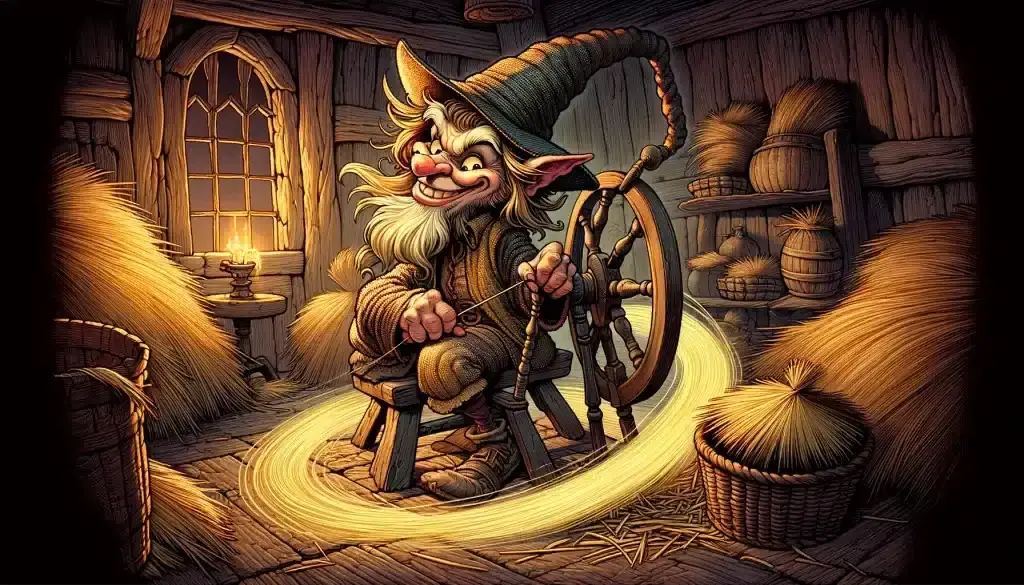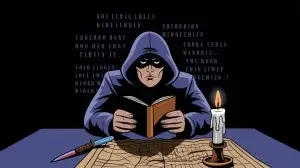Unveiling Rumpelstiltskin Characters and Themes.. The enchanting tale of Rumpelstiltskin, a fairy tale collected by the Brothers Grimm, has captivated audiences with its intriguing characters and profound themes. At the heart of the story are the four primary characters: the cunning Rumpelstiltskin, the desperate miller’s daughter, the avaricious king, and the boastful miller. Their interactions set the stage for a narrative rich in drama and moral quandaries.

Themes in “Rumpelstiltskin” are as varied as its versions found across the globe, from the English “Tom Tit Tot” to the Icelandic “Gilitrutt”. Central to these themes are the consequences of greed and deception, the struggle between power and helplessness, and the ultimate triumph that can come from wit and wisdom. These motifs run through the narrative, providing a deeper layer of meaning beyond the surface-level story.
Understanding the characters’ motivations and how they navigate the trials set before them reveals much about the human condition. The tale becomes a mirror reflecting universal truths about ambition, pride, and the importance of a name. It asserts that even the smallest character can influence the course of events, a sentiment that resonates through time and across cultures.
Origins and Variants of the Tale
The story of Rumpelstiltskin is an enduring one, with its roots deeply embedded in folklore and its variations spanning across the globe. It is a narrative that has been passed down through generations, often reflecting the culture and values of the society that adopts it.
Grimm’s Fairy Tales
The version of Rumpelstiltskin most familiar to contemporary audiences comes from the collection of German fairy tales published by the Brothers Grimm in the early 19th century. Their influence in the world of fairy tales is vast, and their rendition of Rumpelstiltskin is the standard which many people reference. This German fairy tale, part of Grimm’s Fairy Tales, features the eponymous dwarf-like character who possesses magical abilities to spin straw into gold.
International Versions
Beyond the Grimm brothers’ anthology, Rumpelstiltskin has international cousins with a rich diversity of names and nuances:
- England: Known as Tom Tit Tot, this iteration carries similar themes with local twist.
- Scotland: Here, the tale goes by the name Whuppity Stoorie, with a storytelling style distinct to Scottish folklore.
- Iceland: In the icy north, the story is told with a character named Gilitrutt, who lends the tale a unique Icelandic flavor.
- Arabic Countries: The tale features under the name Joaidane جعيدان, offering an Arabic perspective to the story.
- Slovakia: The character is known as Martinko Klingáč, integrating the narrative into Slovak folklore.
- South America: The version called Ruidoquedito resonates with South American cultural elements.
Each international version of Rumpelstiltskin brings with it a fresh take and local traditions, ensuring the continual evolution of this classic fairy tale.
Main Characters and Their Motivations

Each main character in the “Rumpelstiltskin” fairy tale is driven by distinct motivations, ranging from the desire for prosperity to the instinctual need to preserve one’s own future.
The Miller’s Daughter
The Miller’s Daughter, who later becomes the Queen, is thrust into a desperate situation by her father’s lies about her ability to spin straw into gold. Initially, she is a victim of circumstances, but her motivation evolves to protecting her firstborn child when Rumpelstiltskin comes to claim his part of the deal.
Rumpelstiltskin
Rumpelstiltskin himself is a creature of mystery with magical abilities. His motivation does not seem to be greed but rather the thrill of making deals and creating havoc. He bargains for the Miller’s Daughter’s firstborn, demonstrating a complex character whose motivations extend beyond mere wealth. He is cunning and revels in the idea of having a human child for his own enigmatic reasons.
The King
The King is led by greed and the prospect of enriching his kingdom. He is captivated by the prospect of turning straw into gold and is willing to marry the Miller’s Daughter due to this miraculous ability, showing little concern for her well-being so long as his wealth is augmented.
The Miller
The Miller, a poor miller, creates the precarious situation when he boasts that his Daughter can spin straw into gold. His motivation seems to be an attempt to improve his station and potentially to gain favor with the King, yet his thoughtless claim endangers his daughter’s future.
Major Themes and Symbols
The fairy tale “Rumpelstiltskin” by the Brothers Grimm interweaves vivid themes and symbols that reflect on the human condition. Among these, Power and Greed, as well as Names and Identity, stand out as central motifs.
Power and Greed
The desire for power and wealth often leads characters down a path of greed and deception. The miller’s boast about his daughter’s ability to spin straw into gold is a pivotal example, where his exaggeration sets the stage for the story’s conflict. Similarly, the king’s greed becomes evident as he locks the miller’s daughter in a tower, demanding she transform straw into gold or face death. Here, treasures are not only literal but also serve to symbolize the perilous greed that consumes both the miller and the king.
Names and Identity
Names in “Rumpelstiltskin” are deeply symbolic and reveal much about the characters’ true natures and fates. The name “Rumpelstiltskin,” for example, is a crucial symbol of the character’s mysterious identity, while also being his ultimate undoing. In the narrative, knowing Rumpelstiltskin’s name gives the miller’s daughter power over him, demonstrating how knowledge can equate to control. This concept emphasizes the theme that a name holds deep meaning and can be both a source of strength and vulnerability.
Plot Structure and Literary Devices

In exploring the classic fairy tale of “Rumpelstiltskin,” we observe a fascinating interplay between a carefully crafted plot progression and the use of distinct narrative techniques that guide the unfolding of the tale.
Plot Progression
The story of “Rumpelstiltskin” unfolds over several stages, each marked by rising tension and critical turning points. Initially, we are introduced to a miller who boasts that his daughter can spin straw into gold. The king, intrigued by this claim, locks her in a room for three days with the impossible task before her. As her desperation peaks, an imp-like creature appears, offering to spin the straw for her in exchange for her necklace, then her ring, and eventually the promise of her first child.
- Day 1: Necklace for gold
- Day 2: Ring for gold
- Day 3: First child for gold
Each of these transactions escalates the stakes, building up to the climax when the daughter, now queen, must find a way to keep her child. The game of guessing the imp’s name becomes the last obstacle she faces.
Narrative Techniques
Fairy tales often employ symbols and patterns to resonate with the reader. In “Rumpelstiltskin,” the act of spinning straw into gold can be seen as a symbol of turning the commonplace into something of great value, which is a recurrent theme in fairy tales.
- Symbols: Straw (commonplace), Gold (value), First child (future)
- Game: The name guessing game introduces a playful yet tension-filled element, where the stakes are incredibly high, making it clear who the villain of the piece is.
The tale also pivots on the use of the “rule of threes,” a common literary device in fairy tales which is seen in the three days of spinning and the three objects of payment. Additionally, dialogue is employed to develop the characters swiftly and move the plot along, particularly in the interactions between the miller’s daughter and Rumpelstiltskin.
By exploring these elements, one gains a deeper appreciation for the craftsmanship behind this enduring fairy tale.
Cultural Influence and Adaptations

The tale of Rumpelstiltskin has transcended its origins, influencing various aspects of culture and spawning numerous adaptations that reflect societal attitudes and values.
Literary Impact
The story of Rumpelstiltskin has left a significant mark on literature, having been included in the Kinder- und Hausmärchen collection by the Brothers Grimm. The central motifs of the narrative, such as the spinning wheel and the power of naming, have become deeply ingrained in the cultural psyche. This fairy tale has been subjected to psychoanalytical scrutiny, revealing underlying themes such as the value of hard work exemplified by the act of spinning straw into gold, and the complexities of human desires and fears symbolized by the enigmatic character Rumpelstiltskin himself.
Literature has often portrayed the character as a demon or poltergeist-like figure, a representation of cunning and trickery. These portrayals reflect the story’s origins in folklore where such entities often serve as cautionary figures, embodying the consequences of immoral behavior or broken promises.
Modern Retellings
Adaptations of Rumpelstiltskin have kept the narrative alive in contemporary culture while often serving to mirror current societal values. The tale’s iteration in the ABC network show Once Upon A Time exemplifies how modern retellings can maintain the core elements of the story while also reinterpreting the characters and themes to engage with today’s audiences. These contemporary versions often offer a more nuanced exploration of the characters, sometimes casting Rumpelstiltskin in a more sympathetic light or exploring the feminist implications of the tale.
Adaptations also reflect the cultural diversification of the story, with different names and variations existing globally, from Tom Tit Tot in England to Whuppity Stoorie in Scotland and Gilitrutt in Iceland. Each version carries its own cultural nuances and lessons, often adapting the core motifs to fit their specific cultural context.
Various translations and interpretations, such as those by Johann Fischart and versions like Poppart, continue to contribute to the story’s rich tapestry of iterations. These retellings echo the tale’s relevance, proving that the core motifs of Rumpelstiltskin—deceit, reward, and the magical transformation of grain into gold—resonate across cultures and ages, while the game of guessing Rumpelstiltskin’s name remains a compelling narrative device that engages the imagination.
Frequently Asked Questions

In this section, you’ll find answers to some of the most common queries related to the characters and themes of the story of Rumpelstiltskin.
What moral lesson can be learned from the story of Rumpelstiltskin?
The moral lesson from Rumpelstiltskin is that honesty and humility are virtues to be upheld, as deceit and greed can lead to downfall. This narrative warns of the consequences of making promises one cannot keep and the dangers of vanity and pride.
Who represents the main protagonist and antagonist in the tale of Rumpelstiltskin?
The main protagonist in Rumpelstiltskin is the miller’s daughter, who becomes a queen, and the antagonist is Rumpelstiltskin himself. She is thrust into challenging situations due to her father’s tall tales, while Rumpelstiltskin’s actions create the central conflict of the story.
What central themes are explored throughout the story of Rumpelstiltskin?
Themes such as power, greed, exploitation, and the triumph of wit over brawn are explored throughout the story. It reflects on human tendencies and societal norms, particularly focusing on the use and abuse of power.
What symbolic significance does the character of Rumpelstiltskin carry within the story?
Rumpelstiltskin symbolizes the unknown and the mysterious forces at work in the world. He represents the consequences of making deals without fully understanding the terms, embodying the perils of engaging with forces one does not comprehend.
How does the character of the miller’s daughter evolve in the tale, and what is her name?
The miller’s daughter, named throughout literature as various names but commonly referred to as just that, grows from a naive girl into a determined and resourceful woman. Her wit and fortitude ultimately enable her to overcome her dire circumstances.
What are the various conflicts presented in the story of Rumpelstiltskin?
The story presents several conflicts, including man vs. supernatural, with the miller’s daughter against Rumpelstiltskin, and man vs. self, showcasing her internal struggle to outsmart Rumpelstiltskin. Man vs. society is also depicted through the impossible demands placed on her by the king.
Steve is the creative force behind My Unique Tales, a blog dedicated to sharing captivating stories that explore the human experience in all its complexity. With a passion for writing and a talent for crafting engaging narratives, Steve's blog is a treasure trove of imaginative tales that transport readers to other worlds and challenge them to see things from new perspectives. From epic adventures to intimate character studies, Steve's stories are always thought-provoking and emotionally resonant. With a growing following of readers who appreciate his unique voice and creative vision, Steve is quickly becoming a rising star in the world of online storytelling.






